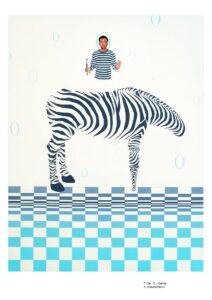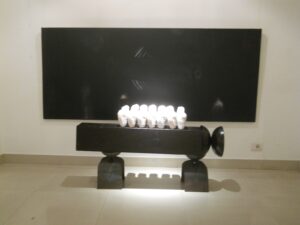Sunanda K Sanyal
(Catalog Essay: Academy of Fine Arts, Kolkata, India, 2022)
Why do enormous skeletal remains lie around barren landscapes and beaches? Whose journeys are interrupted by a destroyed bridge? What happens in the sky above a kneeling human in a supplicating gesture? Where is the weary man headed up a hilly path, dragging a wheelbarrow full of bones? Such are the questions that pique our curiosity about Pradosh Paul’s paintings, drawings, photographs, and videos. While seeking decisive answers would be futile, tracing the process leading to these questions will expose entry points to Pradosh’s creative enterprise that might not be accessible by simply looking at the images.
I am not among those who believe art mirrors life. For me, art refracts life. Dip a stick into a bucket of clear water, and the section of the stick under water will appear crooked, at an angle to the part above. It is an illusion called refraction. Yet precisely as an illusion, it is also real—not tangibly real, but real in the sense that it is an observable and intelligible phenomenon caused by the laws of optics. This apparent contradiction is what characterizes art in my mind. Art may draw on life, but as fiction, it never actually mirrors life; rather, it displaces and re-presents corporeality with a twist. And as fiction refracting life, art is concrete and real in its own way, within its own discourse. It makes sense, therefore, to inquire how the trajectory of Pradosh’s creative pursuits –the formal, conceptual, and aesthetic routes that converge into his images—provide a refracted vision of his lived experience. The exhibition, which offers much of the work he has done in the last five years, represents a turning point in his practice. It all began with an accidental encounter with a dying horse.
Epiphany at the Maidan
The Maidan is one of the last stretches of green open space left in Kolkata. Located between the Hooghly River and the city’s commercial district and bordered on its southern end by the immense marble palace of the Victoria Memorial Hall centered in its groomed lawns, it is a conspicuous landmark from the colonial era that has remained relatively untouched amid radical changes in the skyline around it. This is where the males of the city’s early Bengali middle-class deeply rooted in feudal values — the babus— had their leisurely evening rides in horse-drawn private coaches more than a century ago. Relics of that past, archaic coaches embellished with nostalgic decorative motifs now wait across the street from Victoria’s main entrance to take tourists around the Maidan for a price. The section of the Maidan nearby is a grazing ground for the malnourished ponies that pull the vehicles. One winter morning in 2017, while strolling the area for photographic subjects, Pradosh ran into a moribund mare in the final moments of her life. Intrigued by the sight, he videotaped the scene at length. The act of capturing the pony’s last moments, coupled with his failure to draw attention of the authorities to her plight, brought a drastic shift in Pradosh’s contemplation of art and life.
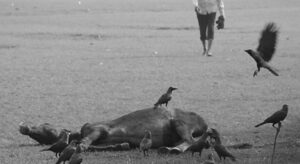
In Death Throes (still from video), 2019.
It is uncomfortable to watch In Death Throes, edited in 2019 into a five-minute video. Yet it is also captivating. Initially seated and visibly in pain, the pony eventually prostrates on the ground. While she gasps for air, runners and dog-walkers pass by, as does busy traffic on the thoroughfare visible far in the background. She struggles, with waning strength, to sit up and chew grass, only to resign and fall back. Opportunist animals on the food-chain, such as a curious dog and a persistent band of crows, visit the spot, but she is too weak to defend herself. The mood of the scene, however, changes unexpectedly as we are nearly appalled by the aloofness of the world around the dying animal. A man, the upper half of his body cut off by the top edge of the frame, is seen walking toward her, driving the crows away. A second man then appears from the left and gently covers her with a blanket to deter the crows. The shot then slowly zooms into her pale face before fading out.
Several elements contribute to the strength of the piece, the most visible of which is the look of the pony. Since ancient times, the horse has signified beauty and speed in all cultures that had access to it, and possession of horses has always been a symbol of the power and sophistication of their owners. Judged by that standard, the pony in this video, with her malnourished, scarred, feeble body, seems a cruel joke. Yet her repulsive demeanor is precisely what makes her a tragic underdog– a marginalized, oppressed entity struggling to stay alive, a struggle that draws us in. Then there is the rope around her neck, tied to a stake nearby. Having taken tourists around the Maidan, perhaps for years, she is now left to die on her own; and the rope poignantly underscores her servitude, even in death. Third, while the video begins with the ambience of the setting, namely noise from the traffic, an appropriated piece of melancholic music is introduced at around three minutes. This overlap between the atmospheric noises and the faint music sharply enhances the gravity of the scene without making it morbid. The fourth element is the unexpected act of kindness by the two anonymous individuals at the very end so the beast of burden can die with dignity. In a world where humans routinely rob other humans of the dignity of life and death, it is difficult to not be moved by this casual display of human compassion for a discarded animal. Finally, the aspect of this video that we may not initially notice is perhaps the strongest: manipulation of cinematic temporality. It took the pony almost twenty-four hours to die, a substantial part of which is on tape; yet all that “real time” is reduced to five minutes of “reel time”. While the editing decision stems primarily from the medium’s own demand, the outcome powerfully summarizes the horse’s protracted, agonizing journey from life to death. We may only realize this later; but once we do, the compression of time appears symbolic of the frightening shortness of life itself and its transience. In my mind, the convergence of all five components provoking us to think as we walk away from the video is fundamental to any worthy work of art.
Pradosh revisited the spot later that day, only to find the pony still clinging to life. As chance would have it, he fractured his arm from a fall that same evening. Painful though it was, he called the local police station throughout the night to find out about the status of the animal. She died early next morning. Pradosh’s epiphany stemming from this coincidence of the two sufferings might seem surprising to the rest of us, as it is not rarely that we witness a neglected animal die. On a fertile mind, however, such an experience is likely to have a very different impact. It is not uncommon for a visual artist past mid-life, still searching for his own niche, to reflect on the ephemerality of life versus the concrete materiality of the objects he is destined to leave behind. Thus, admits Pradosh, thoughts about loneliness and vulnerability –thoughts like “what is the point in all this?”– gradually preoccupied him after his day at the Maidan. He recognizes a parallel between his first-hand experience of the pony’s solitude in the middle of a bustling city and the Hungarian filmmaker Béla Tarr’s 2011 film The Turin Horse, which had already haunted him. The combined impact of the two led him to wonder about his own predicament as a single man in his late fifties living alone, surrounded by art produced over many years.
There is a difference between being alone, which may be voluntary, and being lonely, which usually is not. While the artist as a lone genius in his studio choosing the companionship of his art (the white male artist has been the protagonist in this myth all along) over human connection is a cherished notion from Europe’s Romantic era, it always came with the specter of loneliness lurking in the shadows. It is his confrontation with this specter that compelled Pradosh to refract not only his own but humanity’s existential vulnerability via the agony and loneliness of a dying animal. And such refractions of life constitute his current body of work.
I have known Pradosh Paul for close to four decades. He was one of those students who devoured the archaic skills and conventions offered at Kolkata’s art schools. What is more, raised rurally but educated in the city, he is sort of a bridge between rural and urban Bengal. Pradosh is a man of multiple skills: he sings and plays the flute reasonably well, for instance, and has a flair for writing. It is hardly surprising, then, that faced with existential questions, he would extend his exploration into photography and video– mediums that were not part of his art school training.
Reforging tropes
Pradosh’s paintings frequently use well-known visual tropes from histories of art. In fact, seen superficially, they might come across as exercises in mere clichés. For example, the solitary individual in a vast undulating hill-scape in From Here to Eternity 1 (2020) may remind us of the German Romantic painter Caspar David Friedrich’s famed Monk by the Sea (1810). Even the pictorial strategy of placing the figure below the horizon line, which magnifies the expanse of the landscape, is strikingly similar. His questioning of the purpose of life has its precedent in Paul Gauguin’s iconic Where Do We Come From? What Are We? Where Are We Going? (1897). The presence of skeletal remains in barren habitats, such as in his From Here to Eternity 3 (2020) and Ballad of the Road 7 (2022) seem not too far from Georgia O’Keeffe’s painted series of animal skulls in the American desert from the middle of the last century. Also consider the sinuous trail, central to several of his pictures. Not only is it a literary and visual trope in Bengali culture (paye-chola path) found abundantly in poems, songs, and pictures, but it is ubiquitous in both Asian and Western landscape painting. To escape the pitfall of clichés, I propose we rigorously inspect two aspects of Pradosh’s work: palette and iconography.

From Here to Eternity I, 2020. Acrylic on canvas, 48” x 60”.
Even a cursory glance at this series across mediums cannot fail to notice the conspicuous absence of color. Except for some of the original footage in the second video, the entire body of work is in black, white, and shades of gray. A monochrome palette, the artist informs, became the norm after his encounter with the dying pony at the Maidan. As we delve into the subject and content of the pictures, it becomes clear that their black-and-white ambience is a key contributory factor: while drawing our attention to the nuances of tonality that are free of distractions of color, it also conveys the gravity of the project’s philosophical inquiry. A sensitive treatment of Pradosh’s iconography will demonstrate the intimate connection between the aesthetic choice of avoiding color and the construction of meaning in these images.
The message of Friedrich’s image is unequivocally Romantic: the monk’s wisdom and spiritual expertise are woefully inadequate compared to the enormity of nature and the power of the Sublime. Pradosh’s protagonist, however, remains anonymous, claiming no exclusive status. While the image cannot escape the Romantic trope of the German painting, the seemingly praying, gender-ambiguous kneeling figure clad in an immaculate robe becomes symbolic of all humanity humbly accepting the insignificance of mortal life in the face of the immense forces of the universe. Gauguin exploited his own advantage as a Frenchman in an alien culture (a highly problematic matter in the context of France’s colonial intrusion into that society) to articulate his questions about the meaning of life. None of Pradosh’s paintings falls into such a Primitivist trap. Unlike Gauguin’s use of a cultural Other as a vehicle for his worldview, minimalistic landscape, a lone horse, a rare human figure, and animal skeletons constitute Pradosh’s iconography. Though the placement of skeletons in the foreground of several of his images can be reminiscent of Georgia O’Keeffe’s imagery, O’Keeffe’s priorities were very different. Combined with intimate views of exotic flowers, her animal remains become abstract patterns. They contribute to the discourse of American abstraction while sidestepping existential questions around mortality. In contrast, time and mortality have paramount roles in Pradosh’s work.
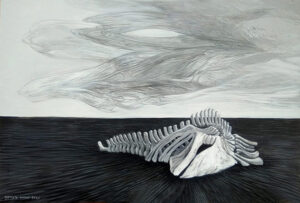
From Here to Eternity III, 2020. Acrylic on canvas, 36” x 54”.
Skeletal fragments that are not always anatomically indicative of specific animals acquire lives of their own. In From Here to Eternity 3 (2020), its overlap with the horizon makes its scale huge and formidable, like remains of an unidentified dinosaur. The looming presence of the object in an expansive landscape, its stark white contrasted by a dark gray ground, generates discomfort, as if we are in an unsettling dream. The land and the sky have decisive roles in the construction of this drama. The terrain does not resemble any habitat from reality. Without a shred of green, the gray, barren ground in several pictures is covered with deep furrow-like marks. Unidirectional in some cases and forming curious patterns in others, the visual dynamism of this texture guiding us across the lower half of a picture is an intriguing compositional device. When employed to delineate empty trails, this surface effect built with dynamic brushwork suggests wheel marks, as if a great many vehicles have trodden the path. At the same time, however, the all-encompassing texture is intimidating because it challenges our conventional perception of a land. The sky in some of the same images, too, defies our expectations of a painted sky. Clouds morph into giant, dynamic shapes, which, upon closer inspection, turn out to be near-abstract skeletal and body fragments. In short, the land and the sky in these images are in a constant flux; and placed between them, a skeleton appears starkly static, as if it thwarts time. Yet embodying the ravage of time and the vulnerability of life, it also subverts that stasis. The tensions generated between these three components enhance a pervading sense of anxiety, a foreboding mood typical of many Surrealist pictures. This feeling is particularly palpable in Ballad of the Road 7 (2022), where a skeleton (of a horse?) aggressively juts into the scene from the right, vestiges of the creature’s mane still clinging to the skull. Sickle-shaped jawbones above eye level look like the menacing claws of a giant predator, thrust inward by the triangular projection of a folded knee. Furthermore, a toppled structure on a stretch of water –a bridge or a pier– in Crestfallen (2020) and what appears to be a destroyed boat in the mid-ground of On the Horizon 3 (2020), reminders of the disruption of unknown abandoned journeys, behave much like skeletons under enigmatic twilight skies.
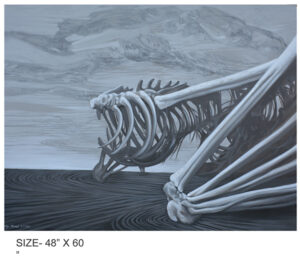
Ballad of the Road VII, 2022. Acrylic on canvas, 48” x 72”.

Crestfallen, 2020. Acrylic on canvas, 72” x 138”.
Hovering between a degree of abstraction and naturalism, these paintings unequivocally acknowledge their debt to Surrealism, which is even more boldly demonstrated by the series of ink drawings on paper. The twisting and turning quasi-abstract animal remains in the ink drawings show ties to Pradosh’s past exploration of abstract potentials of foliage. But here they are transformed into bizarre entities about to transgress the pictorial boundaries. Yet unlike the paintings, their bizarreness does not appear quite threatening; rather, they playfully metamorphose into hybrids between elegant foliage and unidentified creatures, occasionally resembling a giant butterfly, for instance. This enigmatic transformation into some other identity, which the skeletons in the paintings also exhibit, is categorically Surrealist in character.
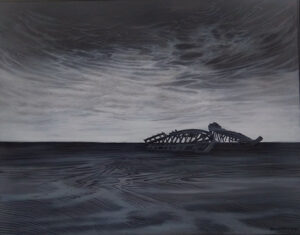
On the Horizon III, 2020. Acrylic on canvas, 48” x 60”.
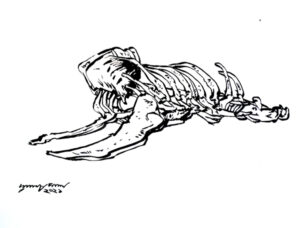
Drawing, 2021. Ink on paper, 9.5” x 12.5”.
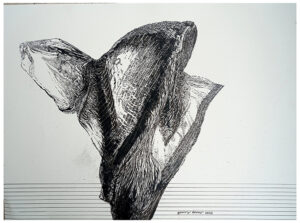
Work on Paper, 2022. Mixed media on paper, 22” x 28”.
Several other paintings in this series, however, have a noticeably different feel. A few of them even have skeletal remains, but they are more docile than intimidating. From Here to Eternity 4 (2021) shows a mysterious backbone lying on the beach under a stormy sky. Without any attempt to invade the space, it is a clear sign of surrender of corporeal life to the inevitability of time and death. Some of the other pictures feature a lone horse. The self-absorbed animal grazes on the side of a winding road in On the Horizon 1 (2017), a dark gray ground littered with bones. In yet others, such as Ballad of the Road 1 (2020), there is simply nothing but an empty trail snaking into the vast distance. Unlike the awe and mystery of the pictures with large skeletons, an overwhelming sense of loneliness and melancholy grips us; a sustained feeling of sadness and quiet, undisturbed by the curiously morphing clouds in the sky. Even in On the Horizon 2 (2020), where such spectral celestial elements descend on the grazing horse, their ominous approach fails to draw her attention.
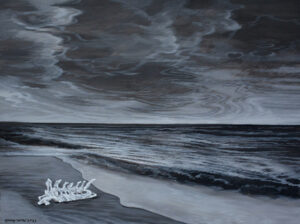
From here to Eternity IV, 2021. Acrylic on canvas, 48” x 36”.
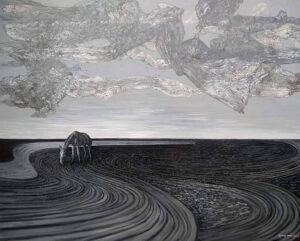
On the Horizon I, 2017. Acrylic on canvas, 72” x 90”.
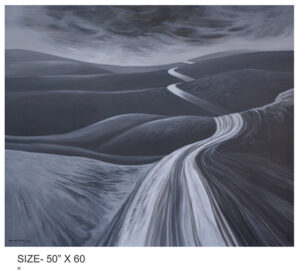
Ballad of the Road I, 2022. Acrylic on canvas, 50” x 60”.

On the Horizon II, 2020. Acrylic on canvas.
I propose we understand Pradosh’s iconography in multiple layers to locate the refractive property of his work. The horse, for me, is the quintessential protagonist in the artist’s deeply personal existential quest. If we are willing to see her as the reincarnation of the pony from the Maidan and an ally of the white-clad kneeling figure in the earlier picture, then as a surrogate for humanity, she becomes the central motif in the artist’s contemplation of life, death, and the passage of time. The enormous crater-like pit with frightfully steep sides on a deeply furrowed land in Banishment (2018), where the pony sits in solitude, provokes us to read the space as the existential trap that none of us can escape, a refracted projection of our own predicament.
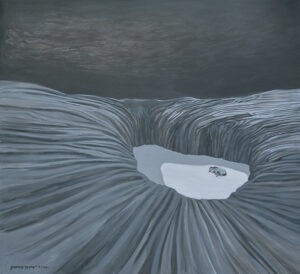
Banishment, 2018. Acrylic on canvas, 40” x 42”.
Next, the pony’s marginalized life of servitude and her lonely demise at the Maidan logically lead us to consider the presence of skeletons. Bones are the most durable tangible evidence of a creature’s corporeal existence; and as the armature of a body, a skeleton is the fundamental tangible marker of a creature’s identity. Yet they cause awe and fear because rejecting all nuances of identity, they harshly expose the frailty of life. A skeleton, paradoxically, is both an abstraction of a body and a disturbingly objective reminder of it, both of which are noticeable in the pictures. The abstraction is in their forms and in their exotic, transformative look; yet both as tangible markers of life and emblems of the inevitability of death, they make us aware of the core existential loneliness that each of us carries within.
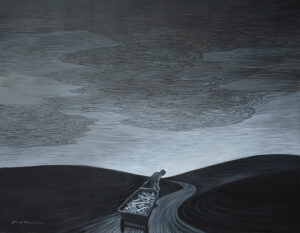
Dawn, 2021. Acrylic on canvas, 36” x 48”.
Finally, when we see the seemingly endless sinuous trail through an empty landscape, we may realize that the paye-chola path is there for that lonesome journey where “eternity” is a euphemism for the uncertain and the unknown. This multi-layered imagery, producing a refracted image of the human condition, culminates in Dawn (2021). Under a somber sky, a stooped human pulls a wheelbarrow full of bones up a hilly path that disappears toward a glowing horizon. There is no question that the stress and confusion of social isolation during the Covid pandemic had its impact on the artist, making his contemplation of loneliness and mortality more urgent. It is not clear if we can locate hope in the bone-carrier’s journey toward the unknown, but it is fair to imagine that the journey has a ballad of its own: the ballad of the road.
Looking without to look within
In its early days, photography was called “the pencil of nature” because unlike painting, it was seen as merely a documentary tool. It is no longer a secret that far from being a neutral record of reality, a photograph is a construct in which the photographer’s subjectivity has as much role as the tool itself; yet we still are unable to abandon our faith in photography’s indexical power. I was initially tempted to draw a parallel between Pradosh’s adventure with the camera and the gaze of the flâneur, that fictional Parisian gentleman so cherished by Charles Baudelaire who casually perused the city streets in the late nineteenth century, dispassionately noticing the sweeping changes of modernity. The urban subjects painted by the French Impressionists are customarily understood as the vision of that imaginary observer. After knowing Pradosh’s photographic production, however, I am hesitant to insist on that analogy, because his photographs are more than fleeting images of Kolkata.
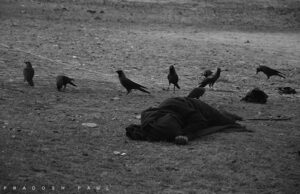
Expectation, 2018. Digital photograph.
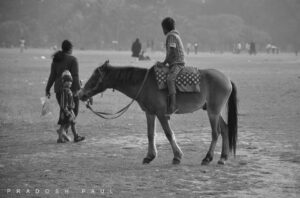
Connection, 2021. Digital photograph.
I consider Pradosh’s photographs visual notes for his studio work. They candidly expose his role as the maker, but in turn, are also influenced by his thoughts cultivated in the studio. The oblique animal-human connection that I trace in his paintings, for example, plays out more openly in his photographs. Though horses around the Maidan are his common subject, Pradosh is equally keen on picturing people as well as human interactions with and around animals, of which Expectation (2018) is a case in point. Eager crows gather around the wrapped body of a sleeping individual in anticipation of a feast on a cadaver, which immediately recalls the dying pony at the Maidan covered in a blanket. Another notable instance is Connection (2021). The backward glance of the walking child articulates his fascination for a pony ride and perhaps envy for the poor kid riding the pony, while the latter also turns to look at him, possibly envying his social privilege. And all the while, the pony remains at the center of this visual exchange. Or consider Curious Duo (2017), a close shot of two sparrows perched on the wheel of a vendor cart. The dark smudges on the upper left corner and the pockmarked white space in the middle of the background wall make a perfectly balanced composition, drawing us to a visual encounter of animals in human habitat that we routinely ignore. I believe such care in the selection of a subject, composition, and shooting addresses some of the same existential preoccupations that guide Pradosh’s studio work. He uses the subtleties captured by the camera to forge more ambiguous refracting devices for the content of his paintings and drawings. Such nuanced photographs have little to do with the dispassionate urban visual survey of the flâneur.

Curious Duo, 2017. Digital photograph.
The lonely fall
100 Ways of Falling (2016) is the only work made as an homage to cinema in its centenary before Pradosh produced the rest of the images shown in this exhibition. With no immediately discernible link to his paintings or photographs either in subject and technique, it nonetheless resonates with aspects of his fundamental thoughts about life and death. Appropriated from a range of movies, it is a fourteen-minute montage of a variety of falls of the human body. It begins with the comical falls of Buster Keaton and Charlie Chaplin, followed by certain rather painful ones made to look funny. At around three minutes, the nature of the falls becomes more serious; and violence appears between eight and nine minutes. In those instances, a fall usually means death. The mood becomes increasingly somber as footage from World War II, namely the Holocaust and the impact of atomic bombs are introduced. Glimpses of iconic movies —Ben Hur, Battleship Potemkin¸ Schindler’s List— contribute to this section. Yet another shift occurs at around thirteen minutes, when the protagonist of Jalshaghar falls to his death, before it all comes back full circle to Chaplin. The final fall, heart-wrenching beneath its hilarity, is in the last scene of Limelight.

100 Ways of Falling (still from video), 2016.
While the production could use more careful editing, its strength is evident on two fronts. One is the power of a new narrative constructed by threading disparate cinematic moments with the common theme of fall. The narrative brilliantly unfolds with the progression of our reactions through the montage. We begin with innocent laughter, followed by occasional “Ouch! That should hurt, but…” response. Our laughs, however, gradually fade with the appearance of death. We are horrified by the immense scale of destruction and trauma, until we find it difficult to watch the bulldozing of dead bodies at liberated Nazi concentration camps. There is a slight relief when, in the clip from Jalshaghar, collective trauma fades into the death of one individual and human atrocity is replaced by a horse-riding accident. At this point, we are anxious to return to laughter at Chaplin’s lovable antics, only to find that something has changed along the way. It is not a full circle to delightful applause after all, because Chaplin’s passionate fiddling despite his severe back injury caused by his fall into a drum makes us laugh and cry at the same time. The other point of the work’s success is its manipulation of the question of context. While it establishes its own contextuality independent of the individual context of each clip, it also offers a curious in-and-out experience for us: a clip from a familiar movie brings a rapid reminder of its original context, whereas we treat an unfamiliar scene only in the context of the montage’s own narrative.
The connection the video has with Pradosh’s paintings, I argue, is camouflaged in the ontology and psychology of fall, of which I draw attention to two issues. First, any fall of a human body, like death, is existentially lonely. People usually fall alone; and the loss of vertical balance, which is the ontological basis of the body’s equilibrium, is strictly the falling individual’s own experience. It is impossible to share with anyone else. Thus, even when multiple bodies fall at once, each of them remains lonely in its own ordeal. Second, the shift to a darker mood around nine minutes into the video gradually compels us to reflect on the difference between the fall of a live body and that of a dead one. Behind our reaction to someone’s fall –be it amusement or concern– is the implicit assumption that the falling person is consciously experiencing the fall. Without that awareness, one has no agency of one’s own fall, nor do we react to the fall of an inanimate object in the same way. Should we, therefore, see the great many bodies being bulldozed into mass graves as falling? Or having already fallen, are they just being dropped into the graves? These questions become more pressing when we wake up to the fact that at this point in the montage, documentary footage is mixed with fictional ones, which means not all the deaths we witness are illusions. This realization should raise new questions for Pradosh’s contemplation of life and death: do violent deaths caused by atrocities of other humans undermine the relevance of the larger issue of the inevitability of human mortality? Does it even make such a philosophical position obscene to ponder? And if so, how do we address such imposed death in existential terms? In sum, a tribute to the medium of cinema made a year before Pradosh embarked on his current project, this video complicates and enriches his subsequent discourse of self-reflection.
Search forward
It is abundantly clear that all the exhibits in this show –paintings, drawings, photographs, videos—are tied with a conceptual thread, which is easy to miss if each image is treated independently. Each of them is like a word in a text. Once they are arranged in the proper syntax, the text offers an eloquent narrative of their maker’s meditative exploration of time and mortality, where the strict black-white-gray palette serves as a unifying agent that alludes to the interdependence of all the images.
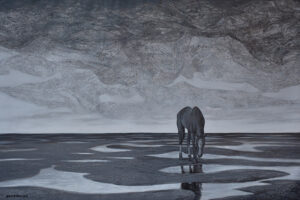
Reflection, 2017. Acrylic on canvas, 48” x 72”.
Triggered by his chance encounter with a dying animal, Pradosh Paul’s existential ruminations were compounded by the devastation and isolation of the Covid pandemic. And the sudden loss of a close friend less than a month before the opening of this show has certainly deepened his thoughts about the vulnerability of life. In Reflection (2018), his lone protagonist calmly gazes at her own image in a shallow puddle of water in a vast landscape under a shape-shifting sky. Let us not see it as the gaze of Narcissus, but as one of profound introspection. There is no question that going forward, the artist’s creative quest will involve an equally intense self-search.

